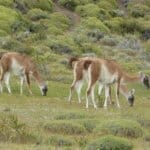It attracts over a quarter of a million visitors annually and is the most visited national park in Chile despite being hundreds of kilometres from the nearest town. It’s also a star of the famed BBC Natural History Unit’s series, “Patagonia”, among others. So, how can a park with such impressive statistics still be relatively unknown?
The giant towers (Cordillera Paine) that are a focal point of this park will probably be familiar to many yet they would be hard pressed to point out even the country or general area on a map.
Welcome to Torres del Paine and wild Patagonia.
The map above shows southern Patagonia’s top sights, including Torres del Paine
It’s not until you spend a night in this pristine wilderness that you realise the grandeur of the landscape around you. Waking up early to discover an early morning mist shrouding our river yet perfectly framing the Torres is still one of my favourite memories of all my travels. It doesn’t fail to pick me up on even the drabbest of mornings.
The Torres del Paine National Park is just over 448,000 acres of protected land in southern Patagonia, about 112km (70 miles) north of the nearest town, Puerto Natales but 312km (194 miles) north of the nearest airport in Punta Arenas. While not exactly on the Moon, the park’s remoteness no doubt contributes to a lack of visitation despite it being the number one visited National Park in Chile. 2 hours from the nearest town by way of tarmac and then gravel track, getting here is a small adventure and achievement in itself.
Torres Del Paine – Getting There
While not as cheap as they used to be, flights down to either Punta Arenas in Chile or Ushuaia in Argentina are by far the easiest option. If you want to get to the Park as quickly as possible, Punta Arenas is the nearest airport (although there is a tiny airport at Puerto Natales which is hardly ever used).
Most people then catch one of the many frequent busses that travel between Punta Arenas and Puerto Natales. Although the busses are frequent, the timetables down here are somewhat more relaxed than you may be used to so please add in a buffer either side of your trip to account for this. Puerto Natales is 3 hours north of Punta Arenas and Torres del Paine is a further 2 hours from Puerto Natales.
If you would like to see what the “end of the world” looks like first in Ushuaia, or you want to add on a stop in Torres del Paine after an Antarctic Expedition, you can catch a bus which takes 13 hours from Ushuaia including a short trip across the Magellan Strait.

Guanaco are all over the park keeping the grass levels down and providing prey for the main predator in the park, the puma.
There are some higher end hotels opening up nearer the park but still outside of it’s boundary that will sometimes offer transport into the park but to save money it’s plenty easy enough to stay in Puerto Natales and catch one of the busses from there. There isn’t a direct bus service to the park from Punta Arenas as yet. You must change in Puerto Natales and catch one of 2 daily services which, in 2016, ran at 0730 and 1430 stopping at the Administration Building, Pudeto (for the catamaran to some in park accommodations) and the Laguna Amarga Ranger Station (end point of the popular W Trek).
If you are staying in El Calafate there is a one day tour you can take to the park for an express view of the main sights but to really appreciate everything the park offers you need to stay overnight. Handily, you can also use this service as bus transport to the park and take another tour back on a different day. Transfer time from El Calafate is 5 hours each way.
Torres del Paine – Staying In The Park
Any development in the national parks in Chile is strictly controlled, but there are a few accommodation options within the park boundary at all budget levels. New regulations came into effect last year; if you want to camp in Torres del Paine you will need to book your spot in advance. Without a prior reservation you will be denied the chance to stay overnight and will more than likely have problems getting a room in Puerto Natales.
- Luxury Lodges – The most expensive option offer small group, expert led day excursions out to all points in the park. They all have stunning views over the Paine Massif and will give you an experience you won’t forget but it will come with a very hefty price tag.
- Eco Yurt Camps – A hot craze at European music festivals, Eco Yurt camps have made it down here to Patagonia. If you like your stay a little more easy going than the luxury lodges but you’re not ready to let go of some of life’s luxuries then this is the option for you.
- Hotels – If staying in a hotel you need to choose it wisely as they rarely offer ground transportation and Torres del Paine covers a huge area and is difficult to get around without a car. You should only choose a hotel as part of an all inclusive package or if you have car hire yourself.
- Refugios – If you like the social aspect of a hiking holiday Refugios offer dorm like accommodation sleeping up to 6 people per room. Breakfast and dinner are provided to save carrying the kitchen on your back as you trek from one site to another. Bedding and sleeping bags can be provided for a small cost if you’re not big on camping back home and there is usually a small shop to buy snacks and the all important beer to share at dinner. If you are doing Patagonia solo like I did, Refugios are a great place to make friends and share adventure stories.
- Estancias – Estancias are part of Patagonia’s heritage and are a great way of seeing the park on horseback. Staying on an estancia though can work out expensive for longer stays. Most people stay for one or two nights to experience the culture and local way of living before moving on.
- Camping – Refugio Campsites have running water and toilet facilities, meals and tents/bedding can be provided if all you want to carry with you is a day pack. Free Campsites are very busy hence rather noisy and are generally poorly maintained while for those really wanting to get away from everything Wild Campsites have no facilities and are usually confined in the higher valleys.
Hopefully what you will take away from this is using budget as an excuse should’t stop you from visiting.

1 hour further along the trail from the Salta Grande Waterfall there is this stunning viewpoint of the mountain over a milky lake.
Torres del Paine – The Weather & When To Go
The weather in this region of the world is famously…. changeable! The park sits at 50° south. There is very little land at this latitude to act as a barrier to the sometimes ferocious winds whipped up in the Pacific until it hits Chile creating wind gusts that can reach upwards of 100kph and can close some trails. The speed also pushes through any weather patterns quickly meaning its not uncommon at all to see all 4 seasons in a few hours while in the park. Any visitor here needs to prepare to meet all 4 seasons with very little warning. Ironically the busiest time in the park, January to April, sees the highest rainfall and fiercest winds. While the park is open year round it can get bitterly cold in the winter. Even in the summer the average temperature barely gets much warmer than 13°C. The shoulder season in September/October is my top pick for when to go because of the lower average rainfall.
You can check the weather directly at the bottom of the official Torres del Paine website as well as a PDF (in Spanish) that explains the new reservations requirements for the trekking routes around the mountain.
Torres del Paine – The No. 1 Attraction
Perhaps the most photographed section of the park is the lagoon at the base of the towers but without a little pre-trip research you could arrive at the park with a shock realisation that the lagoon is actually a demanding 8-10 hour hike through a Lenga Forest and over a moraine field. It’s far from easily accessible but well worth the 8-10 hours of energy getting up to it. You simply can’t do the trek on a day trip into the park. You’re going to have to stay in, or close to the park boundary, to be able to get it done. If you’re on either of the popular treks in the Park, the ‘W’ or ‘O’ (locals hate the name ‘O’ so get used to calling it by it’s proper name, Circuito Grande (Full Circuit)).

Themtowers peak tantalisingly over the moraine field that you must negotiate after clearing the lenga forest.
The hke is split into 2 main obstacles; a moderate hike up and finally through a Lenga Forest after roughly 3-4 hours. Emerging from the forest you will see the final challenge, the moraine field. What looks like small pebbles from afar turn into boulders the size of houses. After an hour of scrambling and shimmying you will arrive at your lunch spot at the base of the towers. Is the view worth it? You better believe it!

The views are worth the hike as you pass the last bus sized boulder and are confronted with this view. And a lot of knackered hikers.
Staying more than 1 night is not a problem. There is more than the Cordillera Paine to see. You can take a boat ride to a neighbouring park to get close to a glacier, take trips out to surrounding lakes (Nordenskjold, Grey, Pehoe). There are many hiking trails in the park that take advantage of the stunning views. One of the more popular is a short 20-30 minute trek to Salto Grande and fantastic views of the Paine Massif even on a grey day. If you have enough time, the trail continues past the waterfall for another hour until you arrive at a hidden lake, perfect for a lunch stop with one of the most beautiful backdrops in the world. Trekking along here you will notice the charred remnants of the forest that once covered the area. The thoughtless actions of an Israeli tourist in December 2011 started a fire that closed the park for a week and ultimately destroyed 16,000 hectares (just under 40,000 acres) of wilderness. The trees take up to 200 years to reach maturity because of the harsh conditions so recovery won’t be swift.

The impressive Salta Grande Waterfall. It’s not the highest of fastest flowing but its surroundings make it perfect.
Torres del Paine – Don’t Leave Your Common Sense At The Border!
Its a harsh reminder of man’s stunning ability to ignore common sense and let stupidity prevail just because “there wasn’t any signs”. Please don’t let it be you. Since 2005 there have been 3 man made catastrophic fires in the park that will take decades to recover from. Lighting fires in the park is illegal and you’re not allowed to stray from the clearly marked trails. Use your common sense so that the park will survive for many more people to witness its beauty.
Torres del Paine has been labelled one of the most beautiful places on the planet and it’s hard to fault that once you’ve seen it for yourself. It’s not easy or quick to get to and it’s far from cheap when you’re there but its a price thousands of visitors are willing to pay to glimpse some of the just over 1,800 sq km of protected nature reserve in this wild corner of Patagonia.
“Traveling – it leaves you speechless, then turns you into a storyteller.” – Ibn Battuta
 Copyright secured by Digiprove © 2017
Copyright secured by Digiprove © 2017






